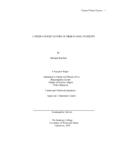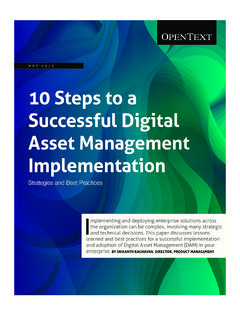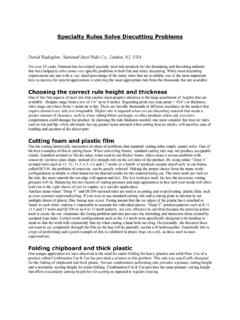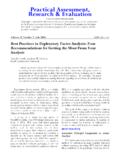Transcription of Choosiong the Right Landscape Plants: Factors to …
1 A3864 Laura G. Jullf a c t o r s t o c o n s i d e rChoosingtherightlandscapeplantsChoosing Plants2:Layout 1 8/28/08 3:28 PM Page acontentsClimatic considerations1 The plant s function inthe landscape4 Size, form, and growthrate considerations7 Ornamental considerations 10 Cultural considerations 14 Native habitat andinvasiveness18 Selecting high-qualitynursery stock19 References20 For more information20 List of scientific names20 Properly placed andcared for landscapeplants can increase thevalue of real , poor plantchoices can become amaintenance problem andcreate an unsightlylandscape. Mismatchedcultural requirements,improper planting (toodeep), and vandalismaccount for more treeand shrub deaths thanall insect and disease-related deaths strive to plantthe Right plant in theright place. ChoosingPlants2:Layout 1 8/28/08 3:28 PM Page bQuestions to consider are: What plants are adapted to my climate? How is the plant to be used in thelandscape?
2 What are the space considerations ofthe site? How big does the plant get and howfast does it grow? Does the plant have showy flowers andfruit? Is the foliage colorful during thegrowing season or in autumn? Does the plant have interesting bark orbranches? What cultural requirements does itneed? Is the plant susceptible to insects ordiseases? Is the plant sensitive to air pollution ordeicing salts? What type of Landscape maintenanceam I willing to provide? Are there any regulations or localordinances preventing me fromplanting? What existing vegetation exists in thearea? Are there any invasive plants ? How do I know if I am purchasing high-quality nursery stock?These questions, along with the selectioncriteria discussed in this publication,should provide the basis for yourlandscape plant theproper plants for a Landscape help toensure the plant has the best chance forhealthy growth, development, and long-term is perhaps the most importantfactor when choosing Landscape ability of a plant to adapt to a givenclimate is referred to as hardiness.
3 Itinvolves tolerance to both low and is very important to usespecies that can survive the temperatureextremes of your the plant isnot tolerant to your particular winterconditions, a perennial will perform like anannual and die over areas usually are slightly warmerthan rural areas due to the heat island effect created by heat from sewers that is trapped andsheltered by buildings and streets alsocontributes to this addition,unique microclimates can be created atspecific example, trees plantedclose to black asphalt pavement will havewarmer conditions in summer and willprobably need more water than thosesame plants planted in the middle of apark areas also may be subjectto early and late frosts, particularly sites athigher elevations and those in low areas orfrost light of these differences,two very important climatic adaptabilitycriteria to consider when choosing plantsare USDA Cold Hardiness Zones andAmerican Horticultural Society (AHS) HeatZones.
4 1 What plants are adaptedto my climate?? Plant selection is one of the mostimportant decisions a gardener, landscaper,or designer makes when landscaping. Note:This publication identifies plantsby their common names;if you re interestedin learning more about a given plant, youmay wish to refer to the list on pages 20 and21 for the full scientific name to ensure thatyou re looking up the same forsythiaChoosingPlants2:Layout 1 8/28/08 3:28 PM Page 1 Cold hardinessUSDA cold hardiness zones are based onthe range of average annual minimumwinter zone numbersindicate colder climates; higher numbersindicate warmer hasthree cold hardiness zones: zone 3(northern Wisconsin), zone 4 (central andsouthwestern Wisconsin), and zone 5(southeastern Wisconsin).The hardinesszones are further divided into two sub-zones of either a (the colder half of thehardiness zone) or b (the warmer).Forexample, the hardiness zone in Portage,Wisconsin, is zone 4b while Stevens Point,Wisconsin, is in zone means that azone 4 hardy plant is cold hardy to 20 F to 30 F with further division of this zone intozone 4a (hardy 25 F to 30 F) or zone 4b(hardy 20 F to 25 F).
5 This subdivision is critical for estimatingcold hardiness of some woody in doubt as to whether you are inthe a or b part of a cold hardiness zone,it is better to err on the side of plants thatare hardy to the colder a is crucial in plant selection,health, and of hardiness canlead to dieback, decline in plant health,death of flower buds, or damage ordestruction to the entire , the flower buds of borderforsythia are not cold hardy to zone 4b butthe flower buds of Sunrise forsythia arecold hardy; therefore, choosing cultivarsand species that are hardy to your area horticultural reference andgardening books and plant labels now listthe subdivision of the zones ( a and b ).When in doubt, ask a local nursery orgarden center for appropriate plants foryour area or contact your local countyExtension office for further toleranceAmerican Horticultural Society Heat Zonesare based on average annual days that areabove 86 has four heat zones:zone 2 (northeastern Wisconsin along theUpper Peninsula of Michigan border),zone 3 (north central Wisconsin and DoorCounty), zone 4 (most of western, central,and eastern Wisconsin), and zone 5(extreme southern and western Wisconsin).
6 Heat zones are particularly important inthe southern and western , but also areimportant in the northern , paper birch and pagodadogwood, species preferring heat zonesbelow 5, are not suitable in some parts ofsouthern Wisconsin, especially in urbanareas, and will not thrive in those are cool, woodland species native tonorthern becomesusceptible to insects, such as bronze birchborer (birch) or golden canker (dogwood)when grown in the poor, dry soils and hightemperature extremes common in urbanand some suburban environments. 2 c h o o s i n g t h e r i g h t l a n d s c a p e p l a n t s usda cold hardiness zones3a3b4a4b5b 35 to 40 F 30 to 35 F 25 to 30 F 20 to 25 F 15 to 20 F 10 to 15 Famerican horticultural societyplant heat zone mapAverage number of daysper year above 86 FAverage annual minimumwinter temperatures23451 7 days8 14 days15 30 days31 45 days646 60 days761 90 daysReproduced with permission of the American Horticultural Society( ).
7 ChoosingPlants2:Layout 1 8/28/08 3:29 PM Page 2 High temperatures are important becausethey affect the supply of carbohydrates(sugars) plants manufacture for themselvesduring the day by stored carbohydrates to produce newleaves, shoots, roots, and arealso involved in several physiologicalprocesses, and generate important plantpigments, such as anthocyanin (red, purple,and blue pigments).When plants withpoor heat tolerance are grown in regionsthat routinely experience high summerday and night temperatures, they often burn up much of their supply of storedcarbohydrates during the evening conditions occur not only in warmerareas of the , but can also take place inurban environments, containers, and like the purple-leafbeech offer an tree haspurple leaves during the cooler parts ofspring and early summer, but whenexcessively high temperatures occur inwarmer heat zones of 6 and higher,respiration rates at night increase andthere are not enough carbohydrates(sugars)
8 Left over for purple pigment leaves can fade to a does not harm the plant butdefeats the purpose of growing thispurple-leaved tree in the first trees will die due to excessively also increasessusceptibility to insects and diseases,especially wood-boring insects and these microclimates, the storedcarbohydrates are used for nighttimerespiration, leaving little for defenseagainst , for mostresidential locations, you do not have toworry about heat tolerance unless aspecies specifically requires a cooler orshady environment with (geographic seed source)One other important adaptability criteriato consider when choosing plants refers to thegeographic origin of the not an issue for vegetatively propagated(via cuttings, budding/grafting, tissueculture, layering) species and cultivars, butit is very important for some native andexotic species that have a wide, nativegeographic range and are primarilypropagated by may not know whether a nursery orgarden center has obtained seed-propagated plant material from a northernseed source, but you can try , eastern redbud is native fromNew Jersey to northern Florida, and westto Illinois and northern have been known to collect seedor buy nursery stock of eastern redbudtrees growing in southern ,such as Tennessee, and sell them innorthern seed-propagated,southern provenances of eastern redbudare less cold hardy and require a shorterdormancy to break , plants grown from southern seed sourcesare prone to winter damage and maybreak bud early in spring, making themvulnerable to frost contrast.
9 The more northernprovenances have greater cold hardinessand should be chosen for use in the UpperMidwest when propagating or growingspecies such as eastern mayalso hold true for non-native, exoticspecies. 3 Trees best grown fromnorthern seed sourcesScientific name Common nameAcer rubrumRed mapleAsimina trilobaPawpawBetula nigraRiver birchCarpinus carolinianaAmerican hornbeamor musclewoodCercis canadensisEastern redbudaCornus floridaFlowering dogwoodFagus grandifoliaAmerican beechLiriodendron tulipiferaTuliptree, tulip-poplarMorella(formerlyNorthern bayberryMyrica)pensylvanicaNyssa sylvaticaBlack gum, tupeloPinus ponderosaPonderosa pinePseudotsuga (most)Sassafras albidumSassafrasTaxodium distichumBaldcypressaRedbuds sold as Columbus strain or Minnesotastrain come from a northern redbudChoosingPlants2:Layout 1 8/28/08 3:29 PM Page 3 The functional use of a plant in thelandscape is a centralconsideration when making can function in multipleways in the Landscape ; this can make yourchoice even more attention tothe particular features of different plants .
10 These may give you ideas about where inthe Landscape they might best be put are some treesHow dense do you want your shade to be?Trees that produce dense shade, such asmaples and oaks, should be planted wherethere is enough space, as well as species work well on the southeast,southwest, and west sides of buildings andhomes by providing cool shade in summer,which can significantly lower your trees drop their leaves inautumn which allows for the low, wintersun to shine through your windows,bringing heat and light into the treesTrees that are to be planted along a streetshould tolerate heat, drought, poordrainage and aeration, soil compaction,low fertility, high pH, deicing salts, and should also be cold hardyto your area and resist treesoften suffer greatly due to lack of waterand restricted rooting area; hence,selection of an appropriate species isimportant for the tree s growth the best choice is not toplant a tree, but to select herbaceousperennials or planting a street tree, remember to look up for power lines and avoid plantingspecies that get large at maturity (tallerthan 30 ft.)










